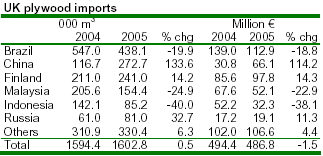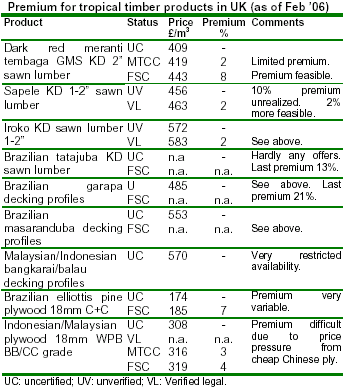|
Report
from the UK
House prices rise in tandem with economic growth
BDO Stoy Hayward, a leading accounting firm, has stated that economic growth will rise to 3.4% in both the
third and fourth quarters in 2006 as compared to 2.4% last year. Its latest Business Trends Report also showed
that companies expect inflation to reach 2.25% in the second half of 2006, above the Treasury¡¯s target of 2%,
and this certainly means that there would be no reduction in interest rates later this year. British manufacturing
expanded in March at the fastest pace in 11 months as accelerating world economic growth lifted exports.
There seems to be some conflicting reports on the housing front with the Halifax bank, the largest mortgage
lender, saying that house prices have risen by an annual rate of 8%, while the Nationwide Building Society only
reports 6.2%.
UK tropical plywood imports continue to decline
UK imports of tropical plywood continued to decline in 2005 due mainly to reductions of Brazilian, Malaysian
and, particularly, Indonesian shipments. Statistics from hardwoodmarkets show that plywood imports from
Brazil dropped 20% to 438,080 m3 (down 19% to euro112.9 million) in 2005. About 40% of the import volume was
tropical plywood. Exports of Malaysian plywood to the UK slipped 25% to 154,412 m3 (down 23% to euro52.1
million) in 2005 while those from Indonesia tumbled 40% to 85,241 m3 (down 38% to euro32.3 million).

In contrast, UK plywood imports from Finland and,
particularly, from China soared in 2005. UK imports of Chinese plywood surged 134% last year to 272,681 m3
(up 114% to .66.1 million). UK imports from Finland rose 14% to 241,039 m3, worth .97.8 million for an
average unit value of .406 per m3 compared with the much cheaper Chinese plywood (average unit value .242
per m3).
The market shares held by these countries on a volume basis in 2005 were: Brazil 27% (down from 34% in
2004), China 17% (up from 7%), Finland 15% (up from 13%), Malaysia 10% (down from 13%) and Indonesia
5% (down from 9%). However, recent statistics show a decline in UK imports of Chinese plywood (due to
allegations of illegal log use) and a recovery in Malaysian plywood imports (favoured by 3.5% import
duty as opposed to 7% for Indonesian and Chinese products). UK imports of Indonesian and Brazilian
plywood continue to fall in 2006.
UK EcoHomes scheme favours FSC and CSA
TTJ reported that the UK housing corporation Building Research Establishment (BRE) has recently updated
UK¡¯s EcoHomes scheme, which requires social housing developers to achieve a ¡°very good¡± rating in EcoHomes
for 84,000 new homes funded under the ¡ê4bn National Affordable Homes Programme 2006-2008. The scheme
ranks forest certification schemes differently from the government¡¯s Central Point of Expertise on Timber
(CPET). In EcoHomes 2006, developers using FSC and CSA certified timber earn three points while PEFC and
SFI certified wood earns two points towards EcoHomes credits. Independently verified legal timber can secure
one point.
CPET regards FSC, PEFC, SFI and CSA as equals in providing evidence of legal and sustainable timber
sourcing. BRE said EcoHomes was updated to meet CPET guidance and also following consultation with
EcoHomes Timber credits advisory groups. According to BRE, PEFC scored fewer points because of its less
stringent ¡°social criteria¡± compared with other schemes, and due to its probationary status with the government.
The British Woodworking Federation said the updated
scheme could have a big impact on public procurement and will push the use of chain of custody certification
across the timber and wood products sectors.
UK traders ahead of users¡¯ interest in certified wood
An ongoing study for the UK Timber Trade Federation (TTF) and Department for International Development
(DFID), conducted by Forest Industries Intelligence Ltd., has been assessing and tracking periodically the market
price premiums that may be available for ¡°verified legal¡± and ¡°verified legal and sustainable¡± timber in the UK
market. Representatives of around 15 major agents, timber importers and merchants were surveyed in
February 2006. The study shows that corporate social responsibility policies of the large importers in the UK
seem to be ahead of their customers¡¯ interest in certified
forest products. End-user demand for these products is still a small proportion of the overall market (often cited
as less than 1%)
While in the softwood sector there is very wide availability of certified timber products (mostly from
northern Europe) often at no price premium. Availability of these products in the hardwood and plywood sectors,
particularly tropical, is very restricted and only at premium prices. For instance, only a small proportion of
American hardwood species is available certified, and then usually at 3-11% premium for FSC certified wood.
Russian suppliers, in turn, charge 2-2.5% extra for PEFC certified material (e.g. birch plywood). Therefore,
confronted with lack of consistent supply, price premiums and absence of end-user demand, traders see
significant commercial risks in stocking certified hardwood products.
With regards to tropical hardwood, imports of certified Brazilian sawn hardwood lumber and decking profiles as
well as elliotis plywood have become difficult in line with the general deterioration in the Brazilian supply
situation. Securing new stocks of certified timber products from Brazil is estimated to take at least 5
months and require payment of substantial premiums to secure FSC material (see table).

Although overall availability of Asian hardwoods is tight,
MTCC certified meranti sawn lumber is increasingly offered to UK buyers, with some traders reporting a
modest premium of around 2% (see table). UK imports of MTCC certified products amounted to only 7,603 m3
in 2005 but continue to grow. UK importers are placing forward orders of MTCC stock, apparently as an
insurance policy to avoid potential problems with acceptability in public sector contracts and to conform to
internal procurement commitments. Most UK traders reckoned that only a small volume of this wood is
currently sold as certified product and is more commonly mixed in with uncertified stock. Even smaller volumes of
FSC certified meranti and bangkirai from the Deramakot Reserve in Sabah are available on an irregular basis and
can achieve up to 8% premium in the UK market.
The emergence of China as a major plywood supplier has had a detrimental impact on the development of markets
for certified products. Chinese products are usually sold into the UK at 25-30% below the price of comparable
Indonesian, Malaysian and Brazilian products (see article above). This has forced end-user price expectations
down, making it uneconomic for an importer to build up stocks for comparatively expensive certified products for
which there is small end-user demand. UK plywood
firms reported that although allegations of illegal bintagor logs used in Chinese combi plywood initially
slowed its demand in the UK, this was short-lived. Some traders even think that in spite of concerns on lower
quality and legality, the market will inevitably continue to buy uncertified Chinese products due to low prices.
Another detrimental factor, particularly for verified Indonesian plywood, has been the EU¡¯s differential
import duty. The duty of 3.5% for Malaysian plywood as opposed to 7% for both Indonesian and Chinese products
has placed Indonesian plywood at disadvantage. Some traders say that, as result of this, FSC certified
Indonesian plywood is hardly sellable in the UK.
Meanwhile, UK efforts to develop sources of legal and sustainable African hardwood sawn lumber began to
show results in late 2005. Legally verified African hardwood products such as KD lumber are increasingly
being sold into the UK with a market premium of 2-3%. FSC certified African hardwoods (mainly sapele) are
expected to be available later in 2006 from the Congolaise Industrielle des Bois (CIB) concession in
Republic of Congo (see TTM 11:3).

Report
from Netherlands
Conditions point to a sellers¡¯ market
After a long period of inactivity and slow sales that led to a tremendous erosion of sales prices, the market for dark
red meranti (DRM) suddenly took a turn in the last quarter of 2005. From the point of view of the Dutch
market, several factors sparked the recovery. Authorities took measures to stimulate the building sector, the
economy started to recover and, later, spring brought building activity. Undoubtedly, the economic recovery is
a strong influencing factor: there is generally more trust in the future, profits are increasing, unemployment is
declining, the order portfolios of companies are growing and readiness to invest and spend is increasing, so the
fundamentals for a better trading climate are in place.
Whether the economic recovery will continue remains to be seen but it looks more promising this year as the
building sector is pleased with the first quarter¡¯s results. The sector is very confident that growth will be sustained
through spring and summer. Joinery manufacturers have plenty of work for the coming months. In the local trade,
end-user inquires for timber volumes for delivery in the next few weeks are substantial as opposed to negligible
amounts last year. If before traders lured buyers with cut-throat price levels, now the price is less of an issue. It
is now more important whether the seller can supply. Thus, high prices of 3x5¡± (80x130mm) PHND DRM
(euro800 and up per m3) are not depressing sales.
Prices of most raw materials are rising, whether they are gold (at its highest level since the 1980s), oil, edible oil,
latex or metals. Timber is not an exception to this trend and, in line with current demand, CNF Rotterdam price
levels of all species enjoy an upward trend. For Malaysian timber, yesterday¡¯s record high price can be
today¡¯s low. The price goes up daily and even timber like merbau, which is not in such hot demand like
DRM, follows the same trend. Another factor compounding the situation is the gradual strengthening of the Malaysian
ringgit few months ago), which has risen almost 6% from 3.8 to 3.58 against the US dollar.
Furthermore, the volume that can be traded in common standard sizes like 2 1/2x3 1/2¡±, 3x5¡±, 4x5¡±, etc. is very
small as exporters limit their offers to benefit from rising prices. Some items such as DRM shorts and
DRM, gerutu and bintangore strips remain in acute shortage, prolonging problems for moulding factories to offer
machined items like architraves, skirtings, lamscants and solid finger-jointed scantlings 72x120mm.
Stock replenishment remains a problem
Traders with landed stocks are content that sales prices are following at last the price trends in countries of
origin. Nevertheless, concerns on fresh supply continue to rise. Timber can now be sold from stock or unsold
sailing/forward position at good prices, but the question remains how the stock position can be replenished.
Supply difficulties in Southeast Asia and Brazil and production limitations in Africa make fresh supply
problematic. On few occasions, exporters break contracts for better bidding prices elsewhere, a consequence of a
sellers¡¯ market. Gerutu sawnwood is still fully sold out in all dimensions, both wide boards in
1"and 5/4"as well as strips. The current situation is expected to last for
many weeks. As long as (overseas) buyers remain so eager to buy, supply will certainly not improve due to
constraints in producing countries mentioned before.

|